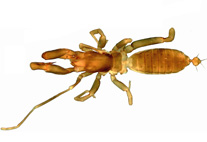Abstract
The taxonomic status of Paguristes praedator Glassell, 1937, and Paguristes oxyophthalmus Holthuis, 1959, is reevaluated, and the two species redescribed and illustrated in detail. Both species are transferred to the genus Areopaguristes Rahayu & McLaughlin, 2010, a genus previously defined to accommodate species of Paguristes sensu lato with 12 pairs of gills instead of 13. Two important characters in both species were found to differ or have not been mentioned in the current definition of Areopaguristes, i.e., the first maxilliped lacking epipod, and dactyls of second and third pereopods unarmed on the ventral margins. The presence of other diagnostically significant characters (e.g., lack of first pleopods in females) previously noted in other species of Areopaguristes, requires the generic emendation of this genus presented herein. With the transfer of A. praedator nov. comb. and A. oxyophthalmus nov. comb. to Areopaguristes, this genus now contains 27 species, of which nine occur in the Americas (four in the eastern tropical Pacific, and five in the western Atlantic).

